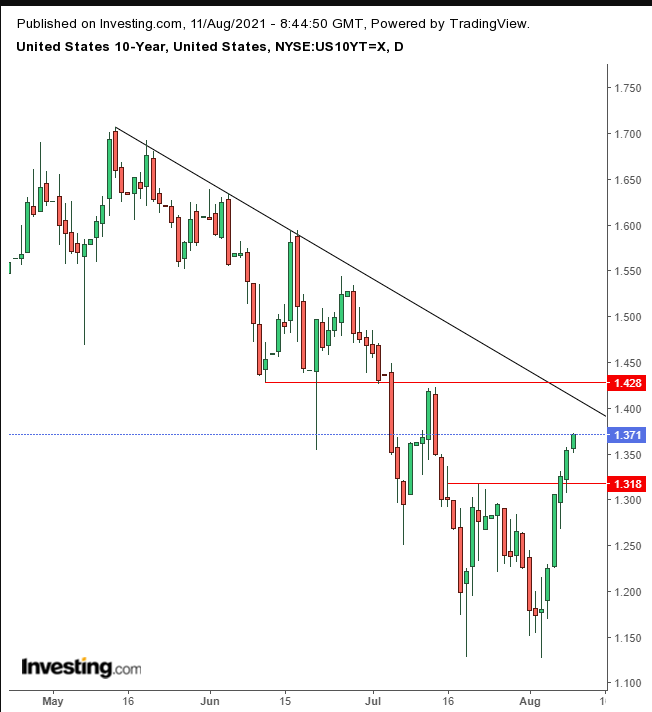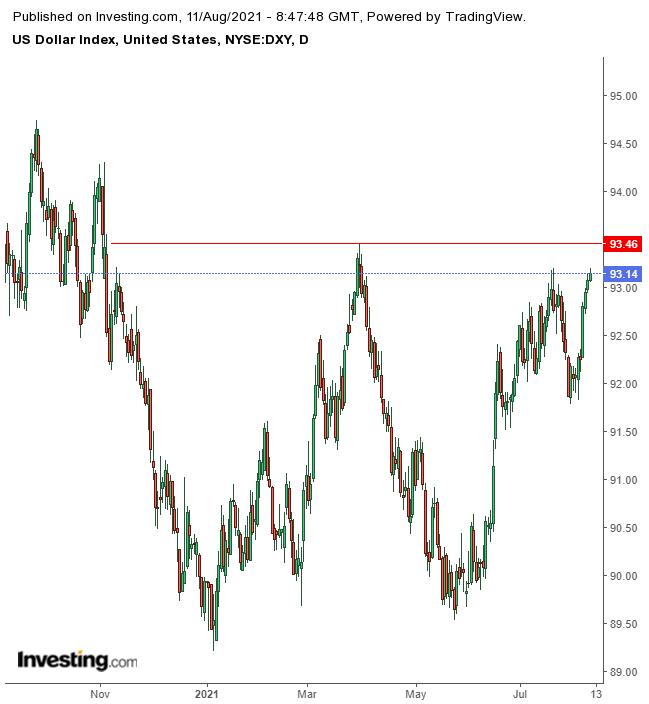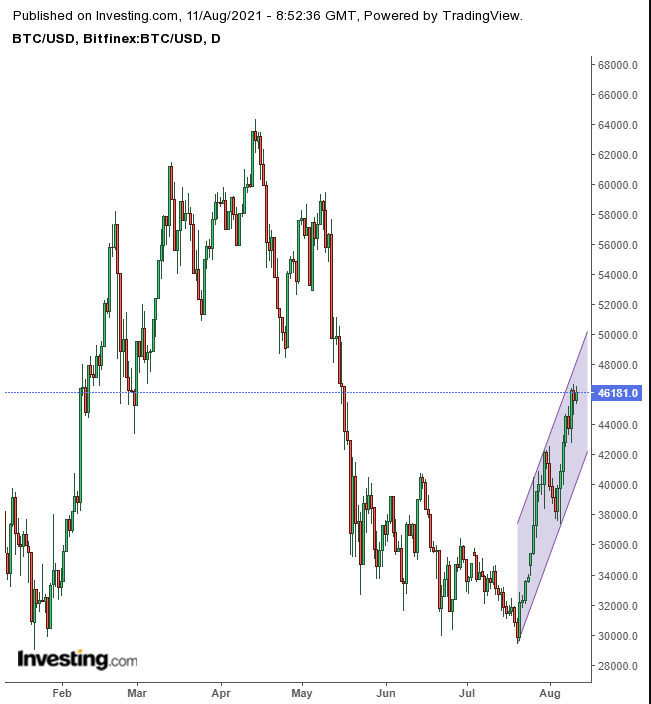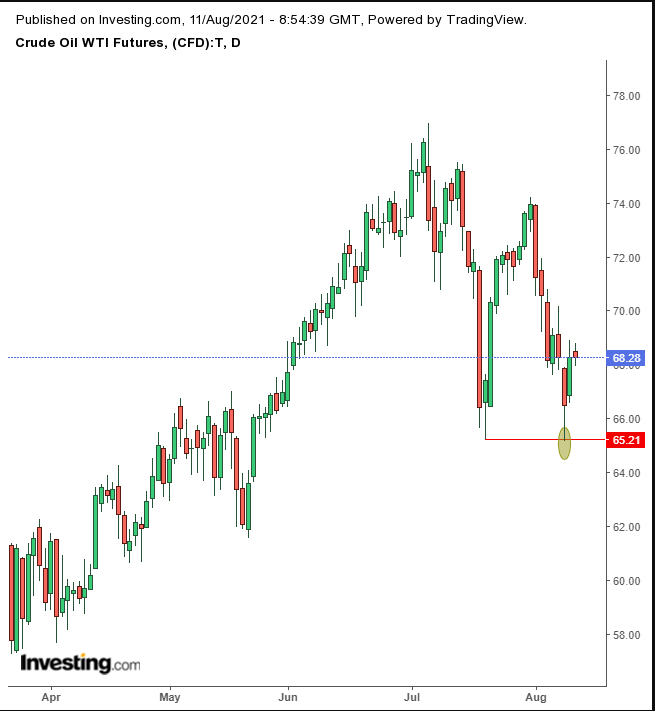- Market narrative at odds with sector analysis regarding the recovery
- Bitcoin bulls defy regulators
- Rebound in gold and oil could be short-lived
Key Events
US contracts for the S&P 500, Dow Jones, NASDAQ and Russell 2000 were all in the red on Wednesday, with contracts on the VIX edging higher. European stocks, however, extended a string of records. The dichotomy between sinking futures and escalating European shares is the result of conflicting views on where the global economic recovery is headed.
All this is taking place ahead of today's US inflation data release, which could be explosive both for current market and policy environments.
The dollar kept pushing higher, as did Treasury yields. Oil resumed its slump.
Global Financial Affairs
Futures on all four major US indices traded in negative territory this morning, after hitting all-time highs during yesterday's Wall Street trade. The two opposing sides of the post-pandemic Reflation Trade, represented by contracts on the Russell 2000—which includes small cap domestic firms that suffered through lockdowns, as well as NASDAQ 100 futures—representing tech companies that benefited from social restrictions, underperformed. Each was about 0.2% down at time of writing and fluctuating.
The Stoxx Europe 600 Index stretched out a record-setting rally for an eighth straight day. Upbeat corporate results from companies like Dutch grocery retailer Koninklijke Ahold Delhaize NV (AS:AD), (OTC:ADRNY), boosted risk-on sentiment, as shares of the international food store chain jumped to record highs.
The current, conflicting market narratives were apparent during the Asian session, which was mixed. Japan’s Nikkei 225 rose 0.6%, outperforming regional peers. Shares in Tokyo popped for the fourth day in a row, boosted by yesterday's new record high for the Dow during the New York session.
Conversely, South Korea’s KOSPI fell 0.7%, making it the regional laggard and extending the benchmark's losses for a fifth consecutive session, dragging the Korean won down with it. According to the Korea Herald, foreign investors offloaded a net 1.6 trillion worth of local shares. Escalating daily cases of COVID have been pressuring the Seoul benchmark, with the outbreak remaining above the 1,000 level for more than a month, despite social restrictions.
A sector analysis of yesterday’s US market activity exposes the current discordance regarding the market's bifurcated narrative. While the mega-cap Dow Jones jumped 0.5% to a new all time high and record close, the day's second-best performer was the small cap Russell 2000, with its 0.2% ascent.
Both indices feature value stocks. On the other hand, the tech-heavy NASDAQ indices, which list mostly growth shares, dropped 0.5%. It's been accepted logic for quite some time that a global recovery will benefit value shares, since they tend to be sensitive to the business cycle, while growth stocks, which tend to see a boost irrespective of economic activity, would take a back seat.
So why did Bloomberg declare that yesterday’s market activity exposed "lingering concerns about the ability of the economy to weather less stimulus and rising COVID outbreaks”? It makes sense to us that investors would be taking profits ahead of key inflation data.
July's inflation numbers might well be high enough to end up rocking the boat once they're released, particularly since tech stocks are now some of the most expensive and have the most outstretched valuations. In our view, that only supports the view that the economic cycle is following its natural course, accelerating from last year’s worst recession since the Great Recession into an economic boom.
Still, one indication of a positive outlook on the economy from investors can be seen via Treasuries, including the 10-year note, which are being sold off for the sixth straight day, the longest such run in a long time.

Yields have completed a small double bottom but now have to contend with the support-resistance levels at 1.43.
Rising yields, on the outlook for faster-than-expected stimulus reduction, pushed the dollar to its highest level since the highs seen last March.

If those levels are bested it will complete a massive double bottom for the USD.
Gold seems to have found its footing.

But this is only occurring after the precious metal, on Monday, hit a new low, extending the commodity's downtrend since the August record peak.
Bitcoin has recouped yesterday’s losses.

While the digital coin found resistance by the price activity in the first half of the year, which may even push it back down, the price is expected to eventually resume moving higher, along with what could prove to be a rising channel.
The cryptocurrency is hovering at its highest levels since May 15, despite a push in the US for broader oversight on the asset class and a proposed tax on cryptocurrency that's part of the Senate's newly passed infrastructure bill now heading for a House vote. Investors should anticipate more regulatory protocols on the horizon.
Oil appeared to find some kind of equilibrium after it rebounded from a three-week low triggered by shrinking stockpiles.

However, after a downday on Monday, much like gold it has established a downtrend.
Up Ahead
- US consumer price index data is released later today. Forecasts anticipate prices increased again in July.
- OPEC's Monthly Oil Market Report is due Thursday.
- The UK reports Q2 GDP on Friday.
Market Moves
Stocks
- The Stoxx Europe 600 was little changed
- Futures on the S&P 500 fell 0.2%
- Futures on the Nasdaq 100 fell 0.2%
- Futures on the Dow Jones Industrial Average fell 0.1%
- The MSCI Asia Pacific Index was little changed
- The MSCI Emerging Markets Index fell 0.4%
Currencies
- The Dollar Index rose 0.1%
- The euro was little changed at $1.1711
- The Japanese yen fell 0.2% to 110.74 per dollar
- The offshore yuan was little changed at 6.4895 per dollar
- The British pound fell 0.2% to $1.3818
Bonds
- The yield on 10-year Treasuries advanced one basis point to 1.36%
- Germany’s 10-year yield was little changed at -0.45%
- Britain’s 10-year yield advanced one basis point to 0.60%
Commodities
- Brent crude rose 0.5% to $70.95 a barrel
- Spot gold rose 0.2% to $1,732.32 an ounce
